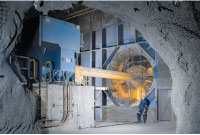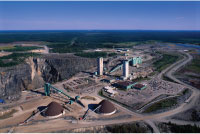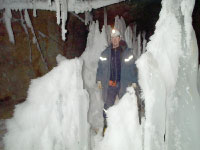 Downward and deeper is the plan Xstrata Copper is following with a $121 million investment to expand its Kidd Mine operations in Timmins.
Downward and deeper is the plan Xstrata Copper is following with a $121 million investment to expand its Kidd Mine operations in Timmins.
"We call it a mine expansion, but what we’re really doing is sustaining the mine," said general manager Tom Semadeni.
Workers at the world’s deepest base-metal mine have already begun diamond drilling toward the 9,500-foot level, following an orebody that remains open at depth. It is projected to extend the mine’s life another year to 2017 and create 75 additional full-time jobs. The Kidd Mine is one of Timmins’ larger employers with approximately 550 employees and an additional 450 contractors.
The primary contractor is Dumas Mining with Genivar performing the engineering. Other local companies involved are Earlton’s Nor-Arc Steel Fabricators, Timmins’ Monarch Automation and Orbit Garant Drilling performing the diamond drilling.
The Mine D zone is estimated to contain 3.4 million tonnes of ore with average grades of 1.48 per cent copper, 6.22 per cent zinc, 0.28 per cent lead and 80 grams per tonne of silver. Current annual production is approximately 45,000 tonnes of copper and 130,000 tonnes of zinc.
 Now in its 42nd year, the mine began as an open-pit operation. However, as time progressed, the company, formerly Falconbridge, followed the orebody downward with a ramp and a shaft. Now, a "cork-screw" type incline spirals down to the 9,200-foot level along with four shafts at various depths. It can take up to an hour to drive down to the bottom from surface. Employees travel through a series of two shafts to get to their work places and ore is hoisted in skips. Supplies and equipment are delivered in one piece directly to the work area using the ramp, saving time and money.
Now in its 42nd year, the mine began as an open-pit operation. However, as time progressed, the company, formerly Falconbridge, followed the orebody downward with a ramp and a shaft. Now, a "cork-screw" type incline spirals down to the 9,200-foot level along with four shafts at various depths. It can take up to an hour to drive down to the bottom from surface. Employees travel through a series of two shafts to get to their work places and ore is hoisted in skips. Supplies and equipment are delivered in one piece directly to the work area using the ramp, saving time and money.
As long as they are able to manage the heat and rock stress and make a profit, Xstrata will continue to follow the orebody to depth, said Semadeni. Exploration drilling is occurring right now below the 9,500-foot and 9,600-foot levels to consider future plans to go deeper still.
"There was concern about whether we can mine safely and efficiently at those depths," he said. "Over the last couple of years, we’ve been able to demonstrate that we can."
Evolving technology, automation and efforts to reduce energy consumption have all played a role during the mine’s development. Shafts were installed to deliver miners and hoist ore to the surface more expeditiously. Now, only shafts No. 2 and 4 are operational, while No. 1 and 3 have been decommissioned. The installation of an internal shaft (No. 4) between the 4,700-foot level and the 9,889-foot level was part of a $250-million, four-year upgrade project completed in 2006.
"We’re only mining down to 8,800 feet right now," Semadeni said. "We built the shaft at that depth (9,889-ft) in anticipation that we would go deeper and we have."
He added that much of the equipment and infrastructure has been upgraded for reliability, operational integrity and efficiency. Automated machinery performs work at the touch of a button within the hoisting room. The skips, cages and conveyor systems are monitored from a central control room on surface and ore is broken to size by teleoperated rockbreakers. All the loaders are run by remote control, allowing the machinery to be sent into production stopes.
 Other challenges in deep mines are ventilation and temperature control. A refrigeration plant on surface pumps cooler air through the ventilation system to help improve working conditions. In the winter, the mine takes advantage of the region’s northern climate by creating ice fields in the old abandoned workings of the mine. During the summer months, air is drawn over the ice and vented to the lower underground workings, estimated to save millions of dollars in operating costs.
Other challenges in deep mines are ventilation and temperature control. A refrigeration plant on surface pumps cooler air through the ventilation system to help improve working conditions. In the winter, the mine takes advantage of the region’s northern climate by creating ice fields in the old abandoned workings of the mine. During the summer months, air is drawn over the ice and vented to the lower underground workings, estimated to save millions of dollars in operating costs.
The company also promotes health awareness for its employees.
"In the spring, we have a safety promotion about the heat, wearing light clothing and being aware of symptoms of heat stress," Semadeni explained. "We encourage people to show up fit for work." Water coolers and air-conditioned lunchrooms, refuge stations, and equipment make the heat more manageable.
Ground conditions are monitored closely. South African instrumentation technology and comprehensive systems for supporting the rock are in place to ensure secure tunnels, drifts and stopes.
Semadeni, a mining engineer who has worked for the company for more than 20 years at its various Canadian operations, has seen significant changes in safety over the years.
"Kidd Mine has achieved a fantastic safety performance. We are seeing historic lows in accident frequencies. We work hard to make sure people go home safely."


